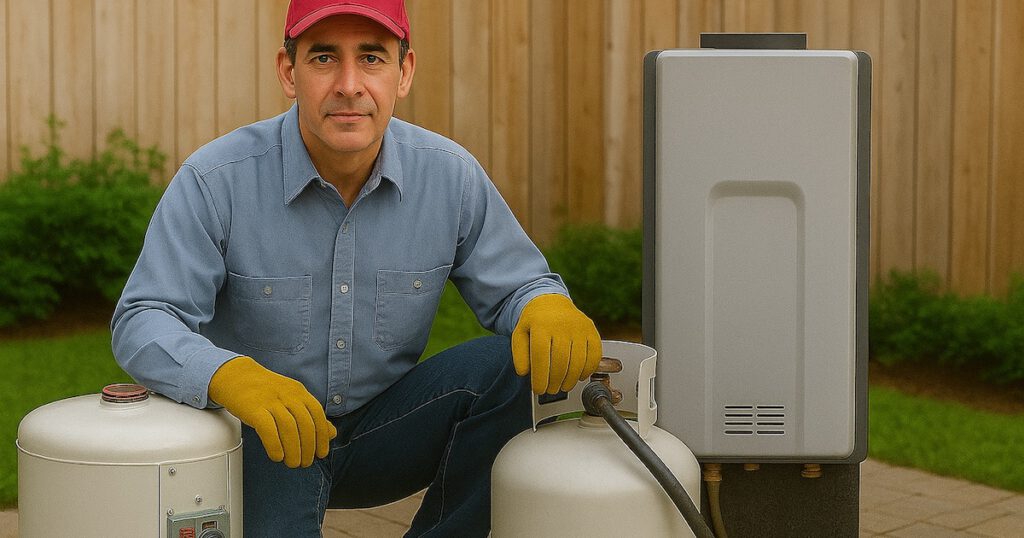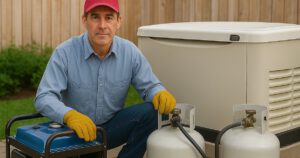
Choosing between traditional tank and tankless propane water heaters involves weighing energy efficiency, upfront costs, hot water capacity, and long-term savings to determine the best option for your household’s specific needs.
This comprehensive comparison examines both systems’ performance, costs, and installation requirements to help you make an informed decision about your home’s hot water solution.
Understanding Water Heater Types
Both tank and tankless propane water heaters provide hot water by burning propane gas, but they differ significantly in design, operation, and efficiency. Understanding these differences helps determine which system best meets your household’s hot water demands.
Traditional Tank Water Heaters
Best for: Consistent hot water needs, budget-conscious homeowners, and households with multiple simultaneous hot water uses
Traditional tank water heaters store preheated water in an insulated tank, providing instant hot water availability. These systems range from 30 to 80 gallons and maintain a constant supply of hot water for household use.
- Storage capacity — Pre-heated water ready for immediate use
- Lower upfront cost — More affordable initial investment
- Simple operation — Straightforward design and maintenance
- Reliable performance — Consistent hot water delivery
Tankless Water Heaters
Best for: Energy efficiency, smaller households, and those seeking long-term savings
Tankless water heaters heat water on demand as it’s needed, eliminating the need for storage tanks. These compact units provide hot water only when required, offering significant energy savings for many households.
- On-demand heating — Heat water only when needed
- Space saving — Compact design requires less installation space
- Energy efficiency — Up to 30% more efficient than tank systems
- Endless hot water — Continuous supply limited only by flow rate
Hot Water Capacity and Performance
Tank Water Heater Capacity
Tank systems provide consistent hot water based on storage capacity:
| Tank Size | Household Size | First Hour Rating | Recovery Rate |
|---|---|---|---|
| 30-40 gallons | 1-2 people | 30-50 gallons | 30-40 GPH |
| 50-60 gallons | 3-4 people | 50-70 gallons | 40-50 GPH |
| 70-80 gallons | 4-5+ people | 70-90 gallons | 50-60 GPH |
Performance Characteristics
- Instant availability — Hot water ready immediately
- Peak demand handling — Can serve multiple fixtures simultaneously
- Recovery time — Time needed to reheat after heavy use
- Temperature consistency — Maintains steady hot water temperature
Tankless Water Heater Capacity
Tankless systems deliver hot water based on flow rates and temperature requirements:
| Flow Rate | Household Size | Temperature Rise | Simultaneous Use |
|---|---|---|---|
| 5-7 GPM | 1-2 people | 40-60°F rise | 1-2 fixtures |
| 7-9 GPM | 3-4 people | 40-60°F rise | 2-3 fixtures |
| 9-11 GPM | 4-5+ people | 40-60°F rise | 3-4 fixtures |
Performance Characteristics
- On-demand heating — No wait time for hot water
- Continuous supply — Hot water as long as gas and water flow
- Temperature control — Precise temperature settings
- Flow limitations — Maximum capacity based on unit size
Energy Efficiency Comparison
Tank Water Heater Efficiency
Traditional tank systems have standard efficiency ratings:
- Energy Factor (EF) — 0.59-0.62 for standard models
- Annual operating cost — $400-$800 depending on usage and rates
- Standby losses — 10-20% of energy used maintaining temperature
- Department of Energy rating — Most qualify as energy-efficient
Efficiency Factors
- Insulation quality — Better insulation reduces standby losses
- Usage patterns — Efficiency improves with consistent hot water use
- Temperature settings — Lower settings improve efficiency
- Maintenance — Regular flushing prevents efficiency loss
Tankless Water Heater Efficiency
Tankless systems offer superior energy efficiency:
- Energy Factor (EF) — 0.82-0.95 for propane models
- Annual operating cost — $250-$600 depending on usage
- Standby losses — Near zero since no storage tank
- Energy savings — 30-50% compared to standard tank systems
Efficiency Advantages
- On-demand heating — No energy wasted maintaining temperature
- Precise heating — Heat only the water you need
- Modulating burners — Adjust flame size to demand
- Advanced controls — Optimize performance automatically
Cost Comparison and Budget Analysis
Initial Purchase Costs
Compare upfront investment requirements:
| System Type | Unit Cost | Installation Cost | Total Investment |
|---|---|---|---|
| 40-gallon Tank | $600-$900 | $300-$600 | $900-$1,500 |
| 50-gallon Tank | $700-$1,100 | $400-$700 | $1,100-$1,800 |
| Tankless (5-7 GPM) | $1,000-$1,500 | $800-$1,500 | $1,800-$3,000 |
| Tankless (7-9 GPM) | $1,200-$2,000 | $1,000-$1,800 | $2,200-$3,800 |
Long-Term Operating Costs
Consider lifetime expenses and savings:
Tank System Costs
- Energy costs — Higher annual propane consumption
- Maintenance — Annual flushing and component replacement
- Repairs — More frequent component failures
- Lifespan — 8-12 years typical service life
Tankless System Costs
- Energy costs — 30-50% savings on propane bills
- Maintenance — Minimal annual service requirements
- Repairs — Fewer components mean less frequent repairs
- Lifespan — 15-20 years typical service life
Payback Period Analysis
Calculate when tankless efficiency pays for itself:
- Average household — 3-5 year payback period
- High usage households — 2-3 year payback period
- Low usage households — 5-7 year payback period
- Utility rates — Higher propane costs accelerate payback
Installation Requirements and Space Needs
Tank Water Heater Installation
Traditional tanks require dedicated space:
Space Requirements
- Floor space — 30-40 gallons: 2×2 feet base required
- Height clearance — 4-6 feet depending on model
- Ventilation — Adequate airflow around unit
- Access space — Room to service and replace components
Installation Considerations
- Gas line requirements — Standard propane line connection
- Electrical needs — 120V outlet for controls
- Venting system — Proper exhaust venting required
- Water connections — Standard plumbing connections
Tankless Water Heater Installation
Tankless units offer flexible installation options:
Space Requirements
- Wall space — 18×14 inches for most residential models
- Height clearance — 2-3 feet depending on mounting
- Indoor/outdoor options — Can be installed in various locations
- Minimal footprint — Saves significant installation space
Installation Considerations
- Gas line upgrade — May require larger gas line for high-demand units
- Electrical requirements — 120V or 240V depending on model
- Venting options — Direct vent or power vent systems
- Water pressure — Minimum 30-40 PSI required
Maintenance and Service Requirements
Tank Water Heater Maintenance
Regular maintenance is essential for tank systems:
Annual Maintenance Tasks
- Tank flushing — Remove sediment buildup
- Anode rod replacement — Every 3-5 years
- Temperature-pressure relief valve — Annual testing
- Gas valve inspection — Check for proper operation
Common Maintenance Issues
- Sediment accumulation — Reduces efficiency and heating capacity
- Corrosion — Tank degradation over time
- Pressure issues — Relief valve and pressure problems
- Heating element failure — Burner or gas valve replacement
Tankless Water Heater Maintenance
Tankless systems require less frequent maintenance:
Annual Maintenance Tasks
- Filter cleaning — Inlet screen maintenance
- Flush system — Remove mineral buildup
- Gas valve inspection — Check burner and gas components
- Performance testing — Verify proper operation
Maintenance Advantages
- No tank flushing — No sediment accumulation
- Fewer components — Less to maintain and repair
- Self-cleaning design — Continuous flow reduces buildup
- Extended service intervals — Longer time between maintenance
Environmental Impact and Efficiency
Environmental Comparison
Both systems have propane as their fuel source:
Tank Systems
- Standby energy waste — Continuous energy use to maintain temperature
- Overall efficiency — 59-62% energy factor rating
- Carbon footprint — Higher emissions due to standby losses
- Water waste — Discarding unused hot water
Tankless Systems
- On-demand heating — No standby energy consumption
- Superior efficiency — 82-95% energy factor rating
- Lower emissions — Reduced energy use and emissions
- Water conservation — Heat only water that’s used
Sustainability Benefits
Tankless systems offer environmental advantages:
- Energy conservation — Up to 40% reduction in energy use
- Water efficiency — Eliminates water waste from unused hot water
- Longer lifespan — Reduced material waste from replacements
- Recycling potential — Components can be recycled at end of life
Choosing the Right System for Your Home
When to Choose Tank Water Heaters
Traditional tank systems work best when:
- Budget constraints — Lower upfront investment preferred
- High hot water demand — Multiple simultaneous users
- Limited space for upgrades — Current installation space adequate
- Short-term ownership — Planning to move within 5 years
When to Choose Tankless Water Heaters
Tankless systems are ideal when:
- Energy efficiency priority — Long-term savings important
- Smaller household — 1-4 people with moderate hot water needs
- Space limitations — Need to save installation space
- Long-term ownership — Planning to stay 7+ years
Household Size Considerations
Match system capacity to household needs:
Small Households (1-2 people)
- Tank option — 30-40 gallon tank sufficient
- Tankless option — 5-7 GPM unit ideal
- Best choice — Tankless for energy savings
- Cost analysis — Tankless pays back in 3-4 years
Medium Households (3-4 people)
- Tank option — 50-60 gallon tank recommended
- Tankless option — 7-9 GPM unit with recirculation
- Best choice — Depends on usage patterns and budget
- Cost analysis — Evaluate payback period carefully
Large Households (5+ people)
- Tank option — 70-80 gallon tank or multiple units
- Tankless option — 9+ GPM unit or multiple units
- Best choice — Tank for capacity, tankless for efficiency
- Cost analysis — Tank often more practical for high demand
Installation and Professional Services
Professional Installation Requirements
Both systems require licensed professional installation:
Tank Installation
- Plumber expertise — Standard plumbing and gas work
- Permits required — Local building and plumbing permits
- Inspection needed — Code compliance verification
- Timeline — 4-6 hours for standard installation
Tankless Installation
- Specialized skills — Gas line sizing and venting expertise
- Permits required — Additional electrical and gas permits
- System evaluation — Water pressure and gas line assessment
- Timeline — 6-8 hours including potential upgrades
Choosing an Installer
Select qualified professionals for your installation:
- Licensing and insurance — Verify contractor credentials
- Propane experience — Experience with gas appliances
- Manufacturer certification — Training on specific brands
- References and reviews — Check customer satisfaction
Advanced Features and Technology
Tank System Features
Modern tank systems include advanced capabilities:
- Smart controls — WiFi connectivity and app control
- Leak detection — Automatic leak monitoring systems
- Hybrid technology — Combination electric/propane systems
- Advanced insulation — Improved energy efficiency
Tankless System Features
Tankless units offer sophisticated technology:
- Modulating burners — Automatic flame adjustment
- Recirculation systems — Instant hot water at fixtures
- Remote control — Smartphone temperature adjustment
- Self-diagnostic systems — Automatic performance monitoring
Making Your Final Decision
Choosing between tank and tankless propane water heaters depends on your household’s specific needs, budget, and long-term goals. Tank systems offer lower upfront costs and reliable performance for high-demand households, while tankless systems provide superior energy efficiency and space savings for smaller households willing to invest more initially.
Consider your household size, hot water usage patterns, available space, and budget when making your decision. Both systems can provide reliable hot water when properly maintained and professionally installed.
Ready to upgrade your water heating system? Consult with local propane professionals for a personalized assessment and recommendations based on your specific needs.
Additional Resources
Learn more about propane water heaters:
- Department of Energy — Energy-efficient water heater guidelines
- Propane Education & Research Council — Propane appliance information
- National Fire Protection Association — Water heater safety standards
- Plumbing-Heating-Cooling Contractors Association — Professional installation resources
Always consult licensed professionals for system evaluation, installation, and maintenance to ensure optimal performance and safety.
About Jennifer Whitaker
Propane industry expert and content contributor for MyPropane.com.
View all posts by Jennifer Whitaker →Related Articles

Best Propane Tanks for Home Use: Complete Buyer's Guide
Sep 17, 2025 • 6 min read
Find the perfect propane tank for your home. Compare residential propane tanks by size, type, and features. Learn about installation,…

Propane Generators: Portable vs Standby Power Solutions
Sep 17, 2025 • 8 min read
Compare propane generators: portable vs standby systems. Learn about power output, fuel efficiency, installation requirements, and cost considerations for home…